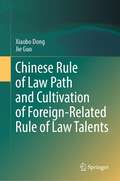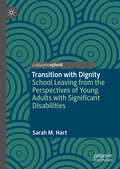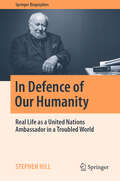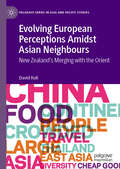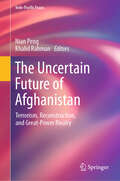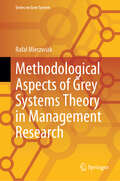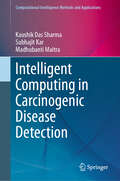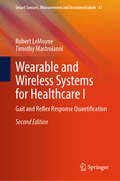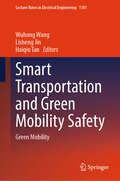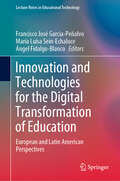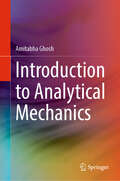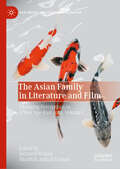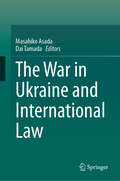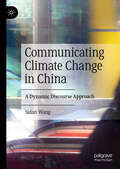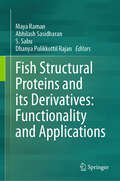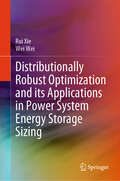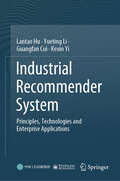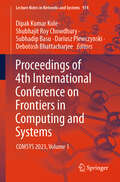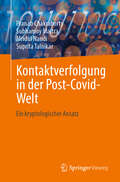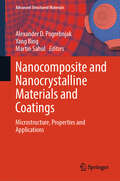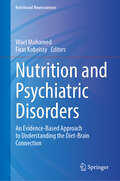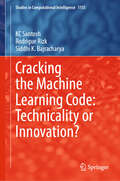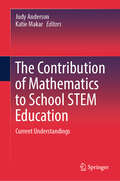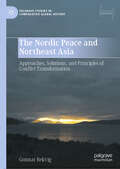- Table View
- List View
Chinese Rule of Law Path and Cultivation of Foreign-Related Rule of Law Talents
by Jie Guo Xiaobo DongThis book systematically explores the historical development, connotation, characteristics and cultural resources of Chinese rule of law path based on the combination theory and practice. It also comprehensively reveals the overall objectives and promotion models of Chinese rule of law path, theoretically expounds the people-oriented nature of Chinese Thought on the Rule of Law and the global initiatives of Chinese rule of law path, and proposes the important guarantee of realizing the global initiatives of Chinese rule of law path——the cultivation of foreign-related rule of law talents. From this book, readers, not only scholars and experts specialized in relevant fields but also layman interested in legal life of modern China, can truly grasp the rich connotation of the socialist rule of law with Chinese characteristics in the new era and have a refreshing understanding of contemporary legal culture of China.
Transition with Dignity: School Leaving from the Perspectives of Young Adults with Significant Disabilities
by Sarah M. HartThis book analyzes the process of leaving school, commonly referred to as 'transition' for young adults with severe, complex, and multiple disabilities. It seeks to challenge prevailing assumptions and offer practical steps towards reversing customary accepted theories, methods, practices, and outcomes. Despite extensive research, policies, and procedures of transition, the reality is that post-school outcomes are worrying for those with significant special needs. Community inclusion depends as much upon in-school procedures and support systems as it does the inclusivity of society itself. This book directly addresses these concerns by examining the experiences of young adults living through their transitions in two countries, Aotearoa New Zealand and the USA. Engaging and highly readable case narratives bring fresh insights on the diversity of disability experiences, portraying the under-explored opportunities involved in a transition with dignity. Disability is an often overlooked aspect of one’s intersectional identity. Post-school transition is therefore positioned less as a procedural function of leaving school and more so an urgent matter of social justice. Readers will benefit from the transformative framing of post-school transition based on the capability approach. Genuine opportunities within the transition of young adults with significant disabilities and those who support them may promote a thriving life for all.
In Defence of Our Humanity: Real Life as a United Nations Ambassador in a Troubled World (Springer Biographies)
by Stephen HillThis book is based on Stephen Hill’s direct experience working in the United Nations for many years as consultant and over a decade as full time Member of Staff—based in Indonesia and part-time in Paris, serving as United Nations Regional Director for Science for Asia and the Pacific as well as Principal Director and Ambassador of the United Nations Agency UNESCO (the UN Educational, Scientific, and Cultural Organization) across South East Asia. It was not always a quiet life. Stephen had to handle the negotiations and aftermath of two of his own UN staff taken hostage in 1996 for five months by freedom fighters into the jungles of West Papua; the May 1998 Revolution in Indonesia where he had to escape his house at 2.00am through mobs and fires while his own security staff had changed into civilian clothes and run off down the street to escape, then evacuate everyone else, but stay to report to the UN Security Council and liaise with the incoming Transition Government. In the early 2000s, Stephen needed to escape Indonesia, under UN Security instruction, from the terrorist organisation, Abu Sayyaf from Mindanao, the Southern Philippines, when they sent a Hit Squad down through Manado and across Sulawesi towards Jakarta to assassinate him in Jakarta because of his collaborative work throughout Mindanao’s previous fundamentalist Islamic conflict zones, amongst other things, bringing literacy to 7,000 villagers, mainly women, building nine radio stations with community support across religious lines, and introducing basic education into Islamic Schools previously teaching only the Koran and Arabic. This book captures all of this rather exciting life but delivers a message from experience—the Power of Community and Cultural Empowerment in successful United Nations Action to bring positive change into the world.
Evolving European Perceptions Amidst Asian Neighbours: New Zealand's Merging with the Orient (Palgrave Series in Asia and Pacific Studies)
by David HallThis book identifies the formation, development and changes in New Zealand perceptions of its Asian neighbours, the work of which is based mainly on New Zealand sources—newspaper reports, Government and Parliamentary papers and documents from New Zealand individuals and organisations. The target audience is those with interest in how European perceptions of Asia were formed in the 19th century and Asia's response to those perceptions and how a country with a strong European culture copes with the need to better integrate with Asian neighbours.
The Uncertain Future of Afghanistan: Terrorism, Reconstruction, and Great-Power Rivalry (Indo-Pacific Focus)
by Khalid Rahman Nian PengThis edited book aims to analyze the domestic politics and foreign relations of the country after the Taliban regained power in August 2021. It touched upon the key issues affecting the Taliban regime, such as peace talks, terrorism threats, BRI cooperation, and the policies of the great powers and neighboring countries toward the new regime in Afghanistan. It makes a significant contribution by incorporating various viewpoints from government officials, university scholars, and think tank experts from China, Japan, and South Asian states. The broad approach and extensive coverage of all relevant countries make this book a valuable resource for more than just a specific academic community. It appeals to a diverse readership, including academics, policymakers, journalists, and general readers. The main content of the book is divided into ten chapters, in which the first chapter briefly introduces the aims and scope of this book. The following 3 chapters look into the domestic politics in Afghanistan. These mainly include the Afghan peace negotiations, the challenge of the Taliban regime, and the security threats and regional response under the Taliban rule in Afghanistan. The next 6 chapters examine US's Afghan policy, China-Afghanistan relations, and Russia, India, Pakistan, Japan’s engagement with Afghanistan.
Methodological Aspects of Grey Systems Theory in Management Research (Series on Grey System)
by Rafaɫ MierzwiakThis book illustrates the application of grey systems theory to management science research, by developing selection procedures for grey analytical methods suitable for forecasting, decision-making, and analysing variable relationships. Highlights the similarity between grey system theory and other uncertainty modelling methods, introducing demarcation criteria between grey system theory, fuzzy logic, and statistical approaches. The book leverages the concept of a "grey space" to move beyond the intuitive understanding of grey, presenting a logical and mathematical model of the concept. Connects grey information with traditional management research paradigms and strategies, serving as a methodological guide to grey methods tailored for social sciences, especially management research. The aim is to facilitate management science readers' understanding of how grey systems theory can be applied in research, providing specific guidance on the use of grey methods in management studies and discussing their possibilities and limitations. This work provides methodological guidelines for conducting research in management science. The primary audience includes management science researchers and doctoral students dealing with empirical research where incomplete and sparse data are a critical factor, and scholars in the grey systems theory community. The book introduces new concepts from the axiomatisation of greyness, appealing to specialists interested in this area.
Intelligent Computing in Carcinogenic Disease Detection (Computational Intelligence Methods and Applications)
by Madhubanti Maitra Kaushik Das Sharma Subhajit KarThis book draws on a range of intelligent computing methodologies to effectively detect and classify various carcinogenic diseases. These methodologies, which have been developed on a sound foundation of gene-level, cell-level and tissue-level carcinogenic datasets, are discussed in Chapters 1 and 2. Chapters 3, 4 and 5 elaborate on several intelligent gene selection methodologies such as filter methodologies and wrapper methodologies. In addition, various gene selection philosophies for identifying relevant carcinogenic genes are described in detail. In turn, Chapters 6 and 7 tackle the issues of using cell-level and tissue-level datasets to effectively detect carcinogenic diseases. The performance of different intelligent feature selection techniques is evaluated on cell-level and tissue-level datasets to validate their effectiveness in the context of carcinogenic disease detection. In closing, the book presents illustrative case studies that demonstrate the value of intelligent computing strategies.
Wearable and Wireless Systems for Healthcare I: Gait and Reflex Response Quantification (Smart Sensors, Measurement and Instrumentation #47)
by Timothy Mastroianni Robert LeMoyneThis book is the second edition of the one originally published in 2017. The original publication features the discovery of numerous novel applications for the use of smartphones and portable media devices for the quantification of gait, reflex response, and an assortment of other concepts that constitute first-in-the-world applications for these devices. Since the first edition, numerous evolutions involving the domain of wearable and wireless systems for healthcare have transpired warranting the publication of the second edition. This volume covers wearable and wireless systems for healthcare that are far more oriented to the unique requirements of the biomedical domain. The paradigm-shifting new wearables have been successfully applied to gait analysis, homebound therapy, and quantifiable exercise. Additionally, the confluence of wearable and wireless systems for healthcare with deep learning and neuromorphic applications for classification is addressed. The authors expect that these significant developments make this book valuable for all readers.
Smart Transportation and Green Mobility Safety: Green Mobility (Lecture Notes in Electrical Engineering #1181)
by Wuhong Wang Lisheng Jin Haiqiu TanThis book gathers selected papers from the 13th International Conference on Green Intelligent Transportation Systems and Safety, held in Qinghuadao, China, on September 16-18, 2022. It presents cutting-edge studies on Green Intelligent Mobility Systems, with the guiding motto being to achieve "green, intelligent, and safe transportation systems". The book presented here helps promote the development of green mobility and intelligent transportation technologies to improve interconnectivity, resource sharing, flexibility, and efficiency. Given its scope, the book benefits researchers and engineers in the fields of Transportation Technology and Traffic Engineering, Automotive and Mechanical Engineering, Industrial and System Engineering, and Electrical Engineering alike. Readers will be able to learn about the advances in green intelligent transportation systems and safety.
Innovation and Technologies for the Digital Transformation of Education: European and Latin American Perspectives (Lecture Notes in Educational Technology)
by Francisco José García-Peñalvo María Luisa Sein-Echaluce Ángel Fidalgo-BlancoThis book provides a critical overview of the current use of learning technologies for educational innovation and examines global trends in educational innovation. It also shares experiences in educational innovation with learning technologies in Europe and Latin America. Despite increasing concerns about the use of technology in education, this book discusses how these can be addressed by focusing on fundamental principles such as personalization, collaboration, engagement, accessibility, and professional development.
Introduction to Analytical Mechanics
by Amitabha GhoshThis comprehensive, introductory textbook on Analytical Mechanics is designed for both seasoned researchers and budding students of Mechanics. This book meticulously outlines the whole route to analytical treatment of the 'science of motion'. Authored with years of teaching expertise, this book unravels new concepts beyond the traditional Newtonian framework, ensuring clarity for beginners. The book is tailored to focus primarily upon areas essential in a first-level course. Unveil innovative treatments helpful in taking the first-time reader through the labyrinthian path along which often analytical mechanics progresses. Ideal for a semester-long study at senior undergraduate and junior postgraduate levels, our text features ample solved examples to reinforce theoretical applications.
The Asian Family in Literature and Film: Changing Perceptions in a New Age-East Asia, Volume I (Asia-Pacific and Literature in English)
by Bernard Wilson Sharifah Aishah OsmanThis book offers a key analysis of the changing perceptions of family in East Asian societies and the dynamic metamorphosis of “traditional” family units through the twentieth century and into the new millennium. The book focuses on investigations of the Asian family as it is represented in literature, film, and other visual media emerging from within China, Japan, South Korea, and Taiwan, and on contestations of the power hegemonies and moral codes that underpin such representations, while also assessing Western and global influences on the Asian family. Individually and collectively, these essays examine traditions and transformations in the evolving conception of family itself and bring together a range of scholars from within and beyond the region to reflect upon the social and cultural mores represented in these texts, the issues that concern Asian families, and projections for future families in their own societies and in a globalized world. Through the written text and the lens of the camera, what directions has the understanding of family in an Asian context taken in the twenty-first century? How have the multiple platforms of media represented, encouraged, or resisted transitions during this time? Amid broader and mutating referential frameworks and cross-cultural influences, is the traditional concept of the “nuclear family” still relevant in the twenty-first century? This book lends further prominence to the diverse literary and cinematic production within East Asia and the eclectic range of media used to represent these ideas. It will be essential reading for scholars of literature, film studies, and Asian studies, and for those with an interest in the cultural and sociological implications of the changing definitions and parameters of the family unit.
The War in Ukraine and International Law
by Dai Tamada Masahiko AsadaThe war in Ukraine is fast approaching its second anniversary since its commencement on 24 February 2022 as a blatant aggression by Russia. As we discuss in detail in this book, there are multiple international legal issues that arise and require addressing. What is more, the very international legal order is under threat, insofar as the fundamental international law obligations are not being complied with and the basic international rules are utterly ignored. This book discusses a number of international law issues arising from the war in Ukraine. It covers not only the traditional subjects of war, such as jus ad bellum, international criminal law, and the law of neutrality, but also the relatively new issues arising from the economic sanctions against Russia, including aspects of the WTO law and international investment law. This book provides the readers with opportunities to reconsider the various legal aspects of the war in Ukraine.
Communicating Climate Change in China: A Dynamic Discourse Approach
by Sidan WangThis book explores how China's media narrate climate policy and climate change. With the rapid growth of economy and carbon emissions, China has been seen as having a key role in addressingclimate change and receives substantial attention from the media. In theChinese coverage, climate change issues can be interpreted as various concernsand ideas involving the dimensions of the economy, energy and emissions, publicinvolvement, science and ecology, and responsibility. In this sense, a discourseapproach can be used to understand how the newspapers construct the climatechange discourse and discourse networks in the coverage. This study selectsthree different newspapers in China, namely People’sDaily, China Daily and Southern Weekend. This book will interest scholars of Chinese politics, environmentalists, and media studies scholars.
Fish Structural Proteins and its Derivatives: Functionality and Applications
by Maya Raman Dhanya Pulikkottil Rajan Abhilash Sasidharan S. SabuThis book brings out a comprehensive collection of information on the structural proteins of fish in both marine and fresh water system. The main focus of this book is to address all relevant aspects of structural proteins of fish and its commercial significance. Fish is a rich and cheap source of protein, and the collagen and myofibrillar proteins, play a key role in food and pharmaceutical industries. Marine-based collagen due to its unique properties have fewer risks of transmitting diseases. These have low molecular weight, are biocompatible, lack religious constraints, and involves cost-effective extraction process. Therefore, it finds wide biomedical applications. The details of its extraction, isolation and characterization, supported with photographs and flow-charts are provided. This book also discusses the different peptides and derivatives of proteins that may have beneficial health significance and other commercial importance. Further, the application of bioinformatics and artificial intelligence in understanding the protein structure in-silico are also discussed in detail. This book is of interest and useful to students, academician, researchers and industrialists/ entrepreneurs, and is a valuable source of reference to the relevant researchers/ students.
Distributionally Robust Optimization and its Applications in Power System Energy Storage Sizing
by Wei Wei Rui XieThis book introduces the mathematical foundations of distributionally robust optimization (DRO) for decision-making problems with ambiguous uncertainties and applies them to tackle the critical challenge of energy storage sizing in renewable-integrated power systems, providing readers with an efficient and reliable approach to analyze and design real-world energy systems with uncertainties. Covering a diverse range of topics, this book starts by exploring the necessity for energy storage in evolving power systems and examining the benefits of employing distributionally robust optimization. Subsequently, the cutting-edge mathematical theory of distributionally robust optimization is presented, including both the general theory and moment-based, KL-divergence, and Wasserstein-metric distributionally robust optimization theories. The techniques are then applied to various practical energy storage sizing scenarios, such as stand-alone microgrids, large-scale renewable power plants, bulk power grids, and multi-carrier energy networks. This book offers clear explanations and accessible guidance to bridge the gap between advanced optimization methods and industrial applications. Its interdisciplinary scope makes the book appealing to researchers, graduate students, and industry professionals working in electrical engineering and operations research, catering to both beginners and experts.
Industrial Recommender System: Principles, Technologies and Enterprise Applications
by Lantao Hu Yueting Li Guangfan Cui Kexin YiRecommender systems, as a highly popular AI technology in recent years, have been widely applied across various industries. They have transformed the way we interact with technology, influencing our choices and shaping our experiences. This book provides a comprehensive introduction to industrial recommender systems, starting with the overview of the technical framework, gradually delving into each core module such as content understanding, user profiling, recall, ranking, re-ranking and so on, and introducing the key technologies and practices in enterprises. The book also addresses common challenges in recommendation cold start, recommendation bias and debiasing. Additionally, it introduces advanced technologies in the field, such as reinforcement learning, causal inference. Professionals working in the fields of recommender systems, computational advertising, and search will find this book valuable. It is also suitable for undergraduate, graduate, and doctoral students majoring in artificial intelligence, computer science, software engineering, and related disciplines. Furthermore, it caters to readers with an interest in recommender systems, providing them with an understanding of the foundational framework, insights into core technologies, and advancements in industrial recommender systems. The translation was done with the help of artificial intelligence. A subsequent human revision was done primarily in terms of content.
Proceedings of 4th International Conference on Frontiers in Computing and Systems: COMSYS 2023, Volume 1 (Lecture Notes in Networks and Systems #974)
by Subhadip Basu Debotosh Bhattacharjee Dipak Kumar Kole Dariusz Plewczynski Shubhajit Roy ChowdhuryThis book gathers high-quality research papers presented at the 4th International Conference on Frontiers in Computing and Systems (COMSYS 2023) held at Indian Institute of Technology Mandi, Himachal Pradesh, India, during 16–17 October 2023. The book is divided into two volumes, and it covers research in “cyber-physical systems for real-life applications” pertaining to AI, machine learning and data science; devices, circuits, and systems; computational biology, biomedical informatics, and network medicine; communication networks, cloud computing, and IoT; image, video, and signal processing; and security and privacy.
Kontaktverfolgung in der Post-Covid-Welt: Ein kryptologischer Ansatz
by Mridul Nandi Subhamoy Maitra Pranab Chakraborty Suprita TalnikarDieses Buch diskutiert modernste Techniken im Bereich der Contact-Tracing-Anwendungen. Dieses in der Medizin gut bekannte Thema hat aufgrund der COVID-19-Pandemie Aufmerksamkeit von Regierungen, verschiedenen Industrien und der akademischen Welt erhalten. Das Buch stellt eine Verbindung zwischen neuen Vorschlägen zu Contact-Tracing-Anwendungen und einer Kontext-Literaturübersicht hauptsächlich aus kryptologischer Sicht her. Da diese Anwendungen die Sicherheit und Privatsphäre von Personen betreffen, ist ihre Analyse aus kryptologischer Sicht von höchster Bedeutung. Daher werden die aktuellen Entwicklungen der weltweiten Vorschläge, einschließlich Singapur, Europa, USA, Australien und Indien, diskutiert. Durch eine eingehende Untersuchung der Designprinzipien jedes Protokolls ist dieses Buch für Forscher, Studierende und Fachleute gleichermaßen wertvoll.
Nanocomposite and Nanocrystalline Materials and Coatings: Microstructure, Properties and Applications (Advanced Structured Materials #214)
by Alexander D. Pogrebnjak Yang Bing Martin SahulThis book is a collection of reports (reviewed) selected from several sections of the IEEE Nanomaterials: Application and Properties-2023 conference. The book is devoted to the study of films, coatings, and materials obtained by various methods of preparation and deposition, for example, magnetron sputtering of targets, vacuum arc deposition , electron-plasma processing, sintering of composites, plasma jet deposition, and other methods for obtaining nanomaterials. The chapters and reports describe superhard coatings, spark, and plasma alloying of materials (metals, semiconductors, polymers, ceramics).
Nutrition and Psychiatric Disorders: An Evidence-Based Approach to Understanding the Diet-Brain Connection (Nutritional Neurosciences)
by Firas Kobeissy Wael MohamedThe book explores the intricate relationship between nutrition, brain function, and psychiatric disorders. The first section of the book delves into the neurobiological aspects of psychiatric disorders, including the neuroanatomy, neuropathology, biochemical and neuropharmacology factors that play a role in the development of these disorders. It also discusses the impact of human nutrition on brain function and the implications of nutrition and metabolism on psychological functioning. The next section focuses on the diet-brain connection, exploring nutritional psychiatry and the current state of evidence, the role of the microbiome, and the effects of certain foods such as chocolate and coffee on mood and mood disorders. The chapters also examine the impact of diet on mental health and cognition across the lifespan and provides a case study of the relationship between diet and psychological health. In the final section, the book delves into the nutritional treatment of psychiatric disorders, including the psychopharmacology of psychiatric disorders and food intake, and multidisciplinary approaches to psychiatric treatment.. Overall, this book offers a comprehensive and evidence-based examination of the complex relationship between nutrition, brain function, and psychiatric disorders, and provides a foundation for further research and development of effective nutritional interventions for the treatment of these disorders.
Cracking the Machine Learning Code: Technicality or Innovation? (Studies in Computational Intelligence #1155)
by KC Santosh Rodrigue Rizk Siddhi K. BajracharyaEmploying off-the-shelf machine learning models is not an innovation. The journey through technicalities and innovation in the machine learning field is ongoing, and we hope this book serves as a compass, guiding the readers through the evolving landscape of artificial intelligence. It typically includes model selection, parameter tuning and optimization, use of pre-trained models and transfer learning, right use of limited data, model interpretability and explainability, feature engineering and autoML robustness and security, and computational cost – efficiency and scalability. Innovation in building machine learning models involves a continuous cycle of exploration, experimentation, and improvement, with a focus on pushing the boundaries of what is achievable while considering ethical implications and real-world applicability. The book is aimed at providing a clear guidance that one should not be limited to building pre-trained models to solve problems using the off-the-self basic building blocks. With primarily three different data types: numerical, textual, and image data, we offer practical applications such as predictive analysis for finance and housing, text mining from media/news, and abnormality screening for medical imaging informatics. To facilitate comprehension and reproducibility, authors offer GitHub source code encompassing fundamental components and advanced machine learning tools.
Australia in AUKUS: Rise of a Leviathan State
by Erik PaulThis book focuses on the making and implication of AUKUS for Australians in their relations with their own state and governance, the Asia-Pacific region and the rest of the world. AUKUS is an incipient military state and a highly dangerous development, moving rapidly to integrate society, the state and the economy in the US imperial project of warfare and global domination. It constitutes the crucible of a Leviathan state, militarising climate change. The study in this book is framed in a geopolitical analytical paradigm of revolutionary and counterrevolutionary movement and power energising together the existential threat of climate change to humans and capitalism, questioning the viability of the nation-state system, highlighting the predicament confronting Australians as a nation. The book’s analysis is presented in four chapters, broadly indicated in the contents page. The book’s architecture is framed in the political philosophy and intellectual legacy of Eric Hobsbawm, Rosa Luxemburg and George Orwell and their contribution to the understanding of the contradictions of the nation-state and imperialism, capitalism and socialism, in the emancipation of humanity from war.
The Contribution of Mathematics to School STEM Education: Current Understandings
by Katie Makar Judy AndersonThis book presents contemporary STEM education research conducted by mathematics education researchers and their collaborators which highlights the important and pivotal role of mathematics in school STEM education. It showcases evidence of the types of integrated curriculum approaches to STEM education which highlight mathematics as a key component and where mathematical concepts can be learnt through integrated tasks. These examples challenge the idea that mathematics is just an application or ‘servant’ to the other STEM subjects and highlight the contribution that mathematics can make to the understanding and practices of the other STEM subjects. This book fills a void in the current research literature on the role of mathematics in STEM education, provides evidence of the possibilities for designing integrated STEM curriculum and highlights current understandings of the role of mathematics in school STEM education. For researchers, it identifies and elaborates gaps to encourage further exploration in this field.
The Nordic Peace and Northeast Asia: Approaches, Solutions, and Principles of Conflict Transformation (Palgrave Studies in Comparative Global History)
by Gunnar RekvigThis book offers a new analysis of the Nordic Peace after its onset in 1814, the year that marks the end to centuries of warfare between the Nordic countries, and the applicability of the Nordic solutions and principles for North East Asian conflicts. Through an analysis of three key post-1814 conflicts that the Nordic region resolved peacefully - the Union of Norway and Sweden (1814-1905), the issue on the duchies of Schleswig-Holstein between Denmark and Germany (1864-1920 & 1955), and the Aaland Islands problem between Finland and Sweden (1809-1922), the book examines how the solutions that underlie the Nordic Peace transcended causes for conflict, and if there is universal potential in the Nordic solutions for similar conflicts in North East Asia
